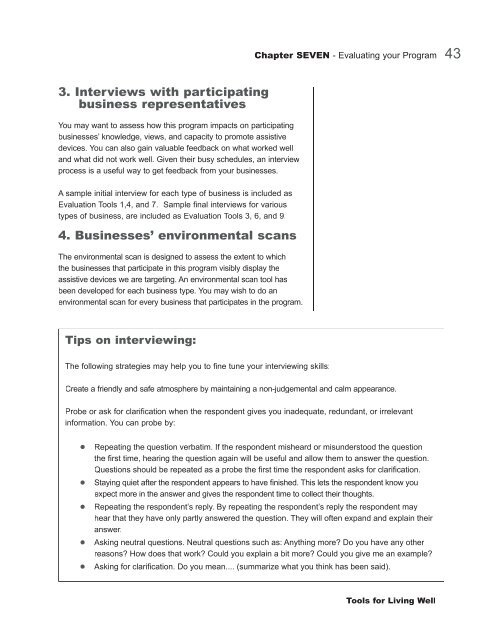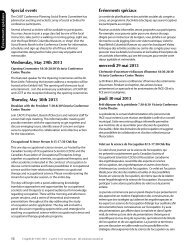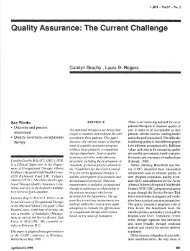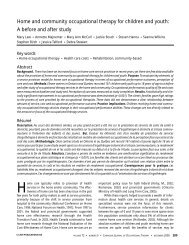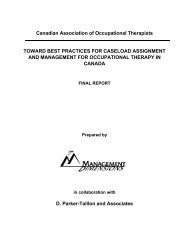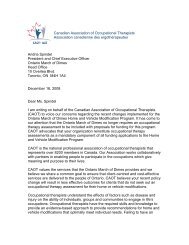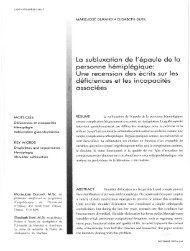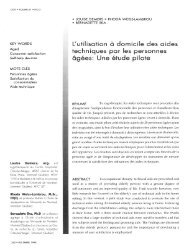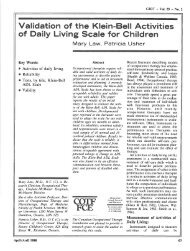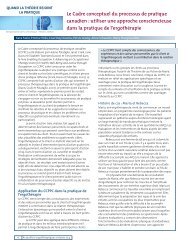Tools for Living Well Toolkit - Canadian Association of Occupational ...
Tools for Living Well Toolkit - Canadian Association of Occupational ...
Tools for Living Well Toolkit - Canadian Association of Occupational ...
You also want an ePaper? Increase the reach of your titles
YUMPU automatically turns print PDFs into web optimized ePapers that Google loves.
3. Interviews with participating<br />
business representatives<br />
You may want to assess how this program impacts on participating<br />
businesses’ knowledge, views, and capacity to promote assistive<br />
devices. You can also gain valuable feedback on what worked well<br />
and what did not work well. Given their busy schedules, an interview<br />
process is a useful way to get feedback from your businesses.<br />
A sample initial interview <strong>for</strong> each type <strong>of</strong> business is included as<br />
Evaluation <strong>Tools</strong> 1,4, and 7. Sample final interviews <strong>for</strong> various<br />
types <strong>of</strong> business, are included as Evaluation <strong>Tools</strong> 3, 6, and 9.<br />
4. Businesses’ environmental scans<br />
The environmental scan is designed to assess the extent to which<br />
the businesses that participate in this program visibly display the<br />
assistive devices we are targeting. An environmental scan tool has<br />
been developed <strong>for</strong> each business type. You may wish to do an<br />
environmental scan <strong>for</strong> every business that participates in the program.<br />
Tips on interviewing:<br />
The following strategies may help you to fine tune your interviewing skills:<br />
Chapter SEVEN - Evaluating your Program<br />
Create a friendly and safe atmosphere by maintaining a non-judgemental and calm appearance.<br />
Probe or ask <strong>for</strong> clarification when the respondent gives you inadequate, redundant, or irrelevant<br />
in<strong>for</strong>mation. You can probe by:<br />
● Repeating the question verbatim. If the respondent misheard or misunderstood the question<br />
the fi rst time, hearing the question again will be useful and allow them to answer the question.<br />
Questions should be repeated as a probe the fi rst time the respondent asks <strong>for</strong> clarifi cation.<br />
● Staying quiet after the respondent appears to have fi nished. This lets the respondent know you<br />
expect more in the answer and gives the respondent time to collect their thoughts.<br />
● Repeating the respondent’s reply. By repeating the respondent’s reply the respondent may<br />
hear that they have only partly answered the question. They will <strong>of</strong>ten expand and explain their<br />
answer.<br />
● Asking neutral questions. Neutral questions such as: Anything more? Do you have any other<br />
reasons? How does that work? Could you explain a bit more? Could you give me an example?<br />
● Asking <strong>for</strong> clarifi cation. Do you mean.... (summarize what you think has been said).<br />
<strong>Tools</strong> <strong>for</strong> <strong>Living</strong> <strong>Well</strong><br />
43


